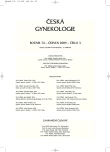Paraneoplastic syndromes in oncogynecology
Authors:
Luboš Minář; H. Al Awad; J. Kümmel
Authors‘ workplace:
Gynekologicko-porodnická klinika LF MU a FN Brno, přednosta prof. MUDr. P. Ventruba, DrSc.
Published in:
Ceska Gynekol 2009; 74(3): 171-176
Overview
Objective:
Informations about paraneoplastic syndromes occurring in gynecological malignancies.
Design:
Literature review with case reports.
Setting:
Department of Gynaecology and Obstetrics, Faculty of Medicine, Masaryk’s University and Faculty Hospital, Brno.
Methods:
Literature review about paraneoplastic syndromes in gynecological malignancies with illustrative case reports.
Conclusion:
As paraneoplastic syndromes known symptoms that accompany cancer, but not linked directly with the progression of primary bearings or creation distant metastases. These symptoms require attention especially because in some cases may be manifestations of primary tumor, which has not yet been diagnosed. The paraneoplastic syndromes that have occurred in the malignancy, which are of interest to oncogynecologists include fever tumor origin, anorexia and weight loss, paraneoplastic syndromes endocrine, neurological, musculosceletal, haematological and skin. As part of the diagnosis is necessary interdisciplinary cooperation involving the participation of not only oncogynecologist, but also dermatologist, neurologist, rheumatologist, hematologist and other specialists according to the current state and the dominant issue patiens.
Key words:
paraneoplastic syndrome, breast cancer and ovaries, dermatomyositis, hypercalcaemia, bisphosphonates.
Sources
1. Anděl, M., Gregor, P., Horák, J., et al. Vnitřní lékařství, díl IIIb – Hematologie. Praha: Galén, 2001, s. 123–124.
2. Coleman, RE. Bisphosphonates in Brest cancer. Ann Oncol, 2005, 16, p. 687-695.
3. Dienstbier, Z., Skala, E. Nádorová diagnostika pro lékaře v praxi. Praha: Grada, 1995, s. 112-113.
4. Esbit, P. Hyperkalcemia of malignancy. New insight into an old syndrome. Clin Lab, 2001, 47, s. 67-71.
5. Harland, CC., Marsden, JR., Vernon, SA., et al. Dermatomyositis responding to treatment of associated toxoplasmosis. Br J Dermatol, 1991, 125, p. 76–78.
6. Chovanec, J., Dostálová, Z., Navrátilová, J. Bisfosfonáty v terapii kostních metastáz karcinomu prsu. Prakt Gyn, 2008, 11, 2, s. 79.
7. Jara, M., Ameriko, JA., Duce, L., et al. Dermatomyositis and flagellate erythema. Clin Exp Dermatol, 1996, 21, p. 440–441.
8. Klener, P. Klinická onkologie. Praha: Galén, 2002, s. 79-81.
9. Kratochvil, F. Dermatomyozitis a polymyozitis. In Kratochvil, F. Využití a klinický význam imunofluorescenčních metod v dermatologii. Acta facultatis medicae Brno, 1988, s. 100–103.
10. Mills, JA. Dermatomyositis. In Fitzpatrick, TB. Dermatology in general medicine, McGraw Hill, 1993, p. 2148–2155.
11. Rowell, NR., Goodfield, MJD. Dermatomyositis. In Rook, A., Wilkinson, DS., Ebling, FJG. Textbook of Dermatology, Champion RH 1998, s. 2555–2565.
12. Slováček, L., Jebavý, L., Kačerovský, J. Paraneoplastická leukocytóza. Inter Med pro praxi, 2004, 5, s. 276.
13. Šmardová, L., Král, Z., Štourač, P., et al. Časný relaps Hodgkinova lymfomu manifestující se jako paraneoplastická cerebellární degenerace (kazuistika). Transfúze a hematologie dnes, 2008, s. 91 -92.
14. Štork, J. Dermatomyositis. In Vosmík a kol. Dermatovenerologie. Praha: Karolinum 1999, s. 170–172.
15. Tomíška, M. Současné možnosti farmakologické léčby nádorové anorexie a kachexie. XII. brněnský den paliativní medicíny, 10/2006.
Labels
Paediatric gynaecology Gynaecology and obstetrics Reproduction medicineArticle was published in
Czech Gynaecology

2009 Issue 3
Most read in this issue
- Unwanted children
- Uterine torsion – the rare compliation of pregnancy
- New diagnostic approach to different hydatidiform mole types, hydropic abortions and relevant clinical management
- Common variable immunodeficiency (Set of case reports)
